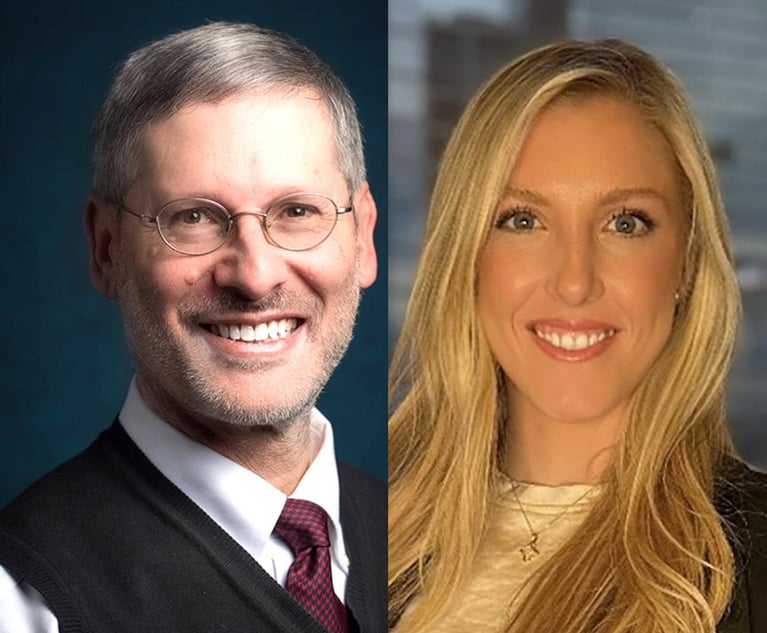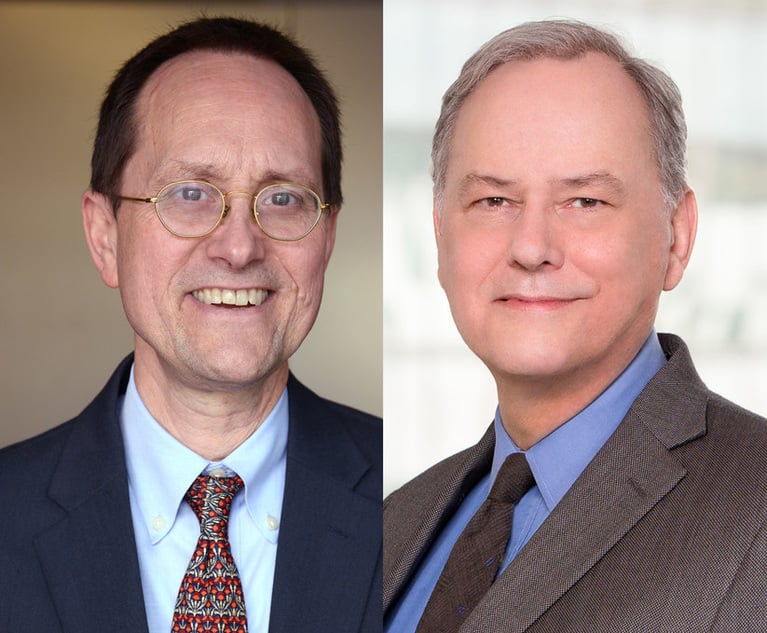Rivkin Radler: The Value of Mentoring, Work Life Balance and Flexible Fees
With no mandatory retirement age, we are pleased to enjoy significant contributions from partners with advanced experience.
March 07, 2019 at 01:27 PM
9 minute read
 Evan H. Krinick, the managing partner of Rivkin Radler, spoke to the New York Law Journal about the advantages and challenges of being a midsize firm in a supersized city. The firm has 190 attorneys and 172 staff members in Uniondale, New York City, Albany and Poughkeepsie. There is also an office in Hackensack, N.J.
Evan H. Krinick, the managing partner of Rivkin Radler, spoke to the New York Law Journal about the advantages and challenges of being a midsize firm in a supersized city. The firm has 190 attorneys and 172 staff members in Uniondale, New York City, Albany and Poughkeepsie. There is also an office in Hackensack, N.J.
“Working hard is endemic to our profession, but we believe in an appropriate work-life balance, with family and interests outside the law given due recognition,” he said.
The interview is part of an occasional series on midsize law firms.
Practice Areas: We are a full-service firm handling both transactional work and litigation. The firm is comprised of our legacy insurance practice in both the coverage and defense arenas, and a commercial practice with areas of law including corporate, real estate, construction, banking, health services, labor and employment, bankruptcy, trusts and estates, immigration, intellectual property, commercial litigation, appellate practice, privacy and data security, white collar crime and investigations, tax and intellectual property. As competitors have remarked, insurance firms would like to have our commercial practice, and commercial firms would like to have our insurance practice.
Q: What is your governance structure and compensation model?
A: The firm is managed on a day-to-day basis by the managing partner and a chief operating officer. The managing partner is the chair of the executive committee, comprised of five additional partners, each of whom is elected to a staggered three-year term with a proviso that they may not succeed themselves. The members of the executive committee represent different practice areas, different offices, different lengths of tenure at the firm and various levels of equity ownership. All decisions are arrived at by consensus at both the executive committee and partnership levels.
The equity partners are compensated by monthly distributions of profit based on points allocated to equity ownership, along with end-of-year bonuses. The allocation of points is reviewed and potentially adjusted by the executive committee on an annual basis based on a variety of objective and subjective factors. A large percentage of fee originations are shared among partners as reflective of our collaborative culture. The compensation process is transparent to all equity partners.
Q: Do you offer alternative fee arrangements?
A: The firm considers alternative fee arrangements to provide clients with predictability and simplicity. Among the various strategies that we have employed include fixed-fee pricing for discrete projects, fixed-fee pricing on an annual basis, fixed-fee pricing with success bonuses, hourly rates with maximum fees, hourly rates with threshold discounts and hourly rates with staffing limitations. We have also occasionally accepted matters on a contingent or partial contingent basis. That being said, the great majority of our work adheres to the traditional hourly billing model, with increased emphasis on realistic budgeting and concomitant accountability for our budgets.
Q: What do you view as the two biggest opportunities for your firm, and what are the two biggest threats?
A: Opportunities: We recently expanded our regional geographic footprint and added depth in a number of significant practice areas. Almost all of our additional talent at the partner level has been internally driven through the relationships and recommendations of our existing partners. The combination of more offices and more substantive depth presents an opportunity to increase our market share in many of our practice areas. We have also invested in new technologies, which enables us to serve our clients more efficiently.
Threats: Safeguarding client data is an ongoing challenge despite our continued investment in cutting edge cyber-security measures. Beyond that, client demands for efficiencies and value continue to challenge all law firms, including our firm, to produce results consistent with client expectations.
Q: The legal market is so competitive now—what trends do you see, and has anything, including alternative service providers, altered your approach? Is your chief competition other mid-market firms, or is your firm competing against big firms for the same work?
A: A significant trend is the increasing variety of disparate legal service providers in the market. In addition to the varied sizes of law firms, there is also increased sophistication in the in-house operations of many clients along with non-traditional competitors in the internet marketplace. We need to be vigilant to ensure that we are providing value-based services to our clients every day. Client service and personal relationships have always been and remain the key to continued success. We are very proud of the many clients that we have been privileged to represent for decades.
The competition for our firm differs by practice area. In some practice areas, we routinely find ourselves across the boardroom table or in the courthouse with firms significantly larger than ours. In other practice areas, our competition is mostly firms of our size.
Q: There is much debate about how law firms can foster the next generation of legal talent. What advantages and disadvantages do midsize firms have in attracting and retaining young lawyers, particularly millennials?
A: Our talent is our most important asset. We invest in our talent in a number of ways and believe that our positive work environment has led to a marked increase in the successful recruitment and retention of highly talented young attorneys. For example, we have added five former New York Court of Appeals clerks in the last few years.
Our investments in attorney recruitment and retention are both formal and informal. We have robust mentoring and attorney development programs. Our mentoring programs take many forms and focus on leadership training and relationship building outside individual practice areas. Our training goes beyond legal skills and substance, and emphasizes the business of law (marketing, social media, client development, time management, law firm finances) and the tools necessary to become a firm leader. We encourage and financially support all of our attorneys to become involved in their community and to seek leadership roles in bar associations and not-for-profit organizations. Each year, we host an awards evening where we recognize significant legal accomplishments, with a particular emphasis not only on client service and case results but on our core values of creativity, mentoring, recruitment, team player activities, community service and pro bono work, among others.
Beyond the programs and awards, we offer the opportunity for associates at all levels to work substantively with partners and clients from the outset of an engagement to its conclusion. There is no substitute for the individual mentoring that occurs when associates and partners work together to achieve client goals. Our staffing model fosters the daily interaction between associates and senior attorneys.
Our partners are devoted to a culture of collegiality, collaboration and commitment, both to clients and to the firm, and our associates are immediately and continually exposed to a work environment that is solely focused on client satisfaction. Our associates thrive when presented with challenging problems to solve and enjoy working in an environment where their contributions to the solution are both encouraged and recognized.
Working hard is endemic to our profession, but we believe in an appropriate work-life balance, with family and interests outside the law given due recognition. We have benefited from the desire of many young attorneys to live in the outer boroughs (Brooklyn and Queens), thus making our suburban office location more accessible.
Q: Does your firm employ any non-lawyer professionals in high-level positions (e.g. COO, business development officer, chief strategy officer, etc.)? If so, why is it advantageous to have a non-lawyer in that role? If not, have you considered hiring any?
A: Our firm administration relies heavily on non-lawyer professionals and we are lucky to have an exceptional team of administrators. Our chief operating officer oversees a talented group of directors and managers that efficiently operates our finance, human resources, legal talent, information technology, library, litigation support, records, office services and network security departments. We also employ a four-person marketing and communications department. These non-lawyers are highly qualified, active in professional organizations and bring many years of practical experience, which allow them to offer unique perspectives on our business strategies.
Q: What would you say is the most innovative thing your firm has done recently, whether it be technology advancements, internal operations, how you work with clients, etc.?
A: Several years ago, partners in our health services group noted that many clients were seeking recommendations for consultants to assist with various non-legal activities, including credentialing, on-boarding, and coding. In response, we partnered with an existing consulting business and created a new entity, jointly owned by the firm and the existing business, and have helped greatly expand the business of the consulting entity, ensuring that our clients had access to high quality consulting services.
More recently, we have undertaken several initiatives intended to enhance our firm's network and data security, including: 1) update of network infrastructure to improve client data and firm data security; 2) employment of third party monitoring of network activity to identify potential client/firm data breaches; and 3) improved encryption methodologies for transferring data between client and firm. We have also begun to use secure, cloud-based storage to foster better remote access.
Q: Does your firm have a succession plan in place? If so, what challenges do you face in trying to execute that plan? If you don't currently have a plan, is it an issue your firm is thinking about?
A: Succession planning is part of the culture of the firm. Each partner, starting at age 62, is required to meet annually with firm management to discuss and plan for succession of clients and to identify, train and promote the next generation of firm leaders. With advance planning and transparent communication, the firm has successfully managed the transition of clients and practice area leadership. In our most recent demographic study, partners aged 50-55 were responsible for the largest percentage of firm business, followed by partners aged 56-60. With no mandatory retirement age, we are pleased to enjoy significant contributions from partners with advanced experience.
This content has been archived. It is available through our partners, LexisNexis® and Bloomberg Law.
To view this content, please continue to their sites.
Not a Lexis Subscriber?
Subscribe Now
Not a Bloomberg Law Subscriber?
Subscribe Now
NOT FOR REPRINT
© 2024 ALM Global, LLC, All Rights Reserved. Request academic re-use from www.copyright.com. All other uses, submit a request to [email protected]. For more information visit Asset & Logo Licensing.
You Might Like
View All
Ben & Jerry’s Accuses Corporate Parent of ‘Silencing’ Support for Palestinian Rights
3 minute read


Trending Stories
- 1Elon Musk Names Microsoft, Calif. AG to Amended OpenAI Suit
- 2Trump’s Plan to Purge Democracy
- 3Baltimore City Govt., After Winning Opioid Jury Trial, Preparing to Demand an Additional $11B for Abatement Costs
- 4X Joins Legal Attack on California's New Deepfakes Law
- 5Monsanto Wins Latest Philadelphia Roundup Trial
Who Got The Work
Michael G. Bongiorno, Andrew Scott Dulberg and Elizabeth E. Driscoll from Wilmer Cutler Pickering Hale and Dorr have stepped in to represent Symbotic Inc., an A.I.-enabled technology platform that focuses on increasing supply chain efficiency, and other defendants in a pending shareholder derivative lawsuit. The case, filed Oct. 2 in Massachusetts District Court by the Brown Law Firm on behalf of Stephen Austen, accuses certain officers and directors of misleading investors in regard to Symbotic's potential for margin growth by failing to disclose that the company was not equipped to timely deploy its systems or manage expenses through project delays. The case, assigned to U.S. District Judge Nathaniel M. Gorton, is 1:24-cv-12522, Austen v. Cohen et al.
Who Got The Work
Edmund Polubinski and Marie Killmond of Davis Polk & Wardwell have entered appearances for data platform software development company MongoDB and other defendants in a pending shareholder derivative lawsuit. The action, filed Oct. 7 in New York Southern District Court by the Brown Law Firm, accuses the company's directors and/or officers of falsely expressing confidence in the company’s restructuring of its sales incentive plan and downplaying the severity of decreases in its upfront commitments. The case is 1:24-cv-07594, Roy v. Ittycheria et al.
Who Got The Work
Amy O. Bruchs and Kurt F. Ellison of Michael Best & Friedrich have entered appearances for Epic Systems Corp. in a pending employment discrimination lawsuit. The suit was filed Sept. 7 in Wisconsin Western District Court by Levine Eisberner LLC and Siri & Glimstad on behalf of a project manager who claims that he was wrongfully terminated after applying for a religious exemption to the defendant's COVID-19 vaccine mandate. The case, assigned to U.S. Magistrate Judge Anita Marie Boor, is 3:24-cv-00630, Secker, Nathan v. Epic Systems Corporation.
Who Got The Work
David X. Sullivan, Thomas J. Finn and Gregory A. Hall from McCarter & English have entered appearances for Sunrun Installation Services in a pending civil rights lawsuit. The complaint was filed Sept. 4 in Connecticut District Court by attorney Robert M. Berke on behalf of former employee George Edward Steins, who was arrested and charged with employing an unregistered home improvement salesperson. The complaint alleges that had Sunrun informed the Connecticut Department of Consumer Protection that the plaintiff's employment had ended in 2017 and that he no longer held Sunrun's home improvement contractor license, he would not have been hit with charges, which were dismissed in May 2024. The case, assigned to U.S. District Judge Jeffrey A. Meyer, is 3:24-cv-01423, Steins v. Sunrun, Inc. et al.
Who Got The Work
Greenberg Traurig shareholder Joshua L. Raskin has entered an appearance for boohoo.com UK Ltd. in a pending patent infringement lawsuit. The suit, filed Sept. 3 in Texas Eastern District Court by Rozier Hardt McDonough on behalf of Alto Dynamics, asserts five patents related to an online shopping platform. The case, assigned to U.S. District Judge Rodney Gilstrap, is 2:24-cv-00719, Alto Dynamics, LLC v. boohoo.com UK Limited.
Featured Firms
Law Offices of Gary Martin Hays & Associates, P.C.
(470) 294-1674
Law Offices of Mark E. Salomone
(857) 444-6468
Smith & Hassler
(713) 739-1250






